Dark Souls 3 port analysis: Durante's verdict
General GPU performance
As you would expect, the graphical splendor of Dark Souls 3 compared to its predecessors does come with a significant increase in GPU requirements. The Steam store page for the game officially recommends a GTX 970, and that recommendation suffices for 60 FPS at the highest possible in-game settings in all the scenarios I tested.
That is, of course, at the common 1080p resolution. Increasing resolution beyond 1080 may be the single greatest graphics improvement to Dark Souls 3, and the most demanding as well.
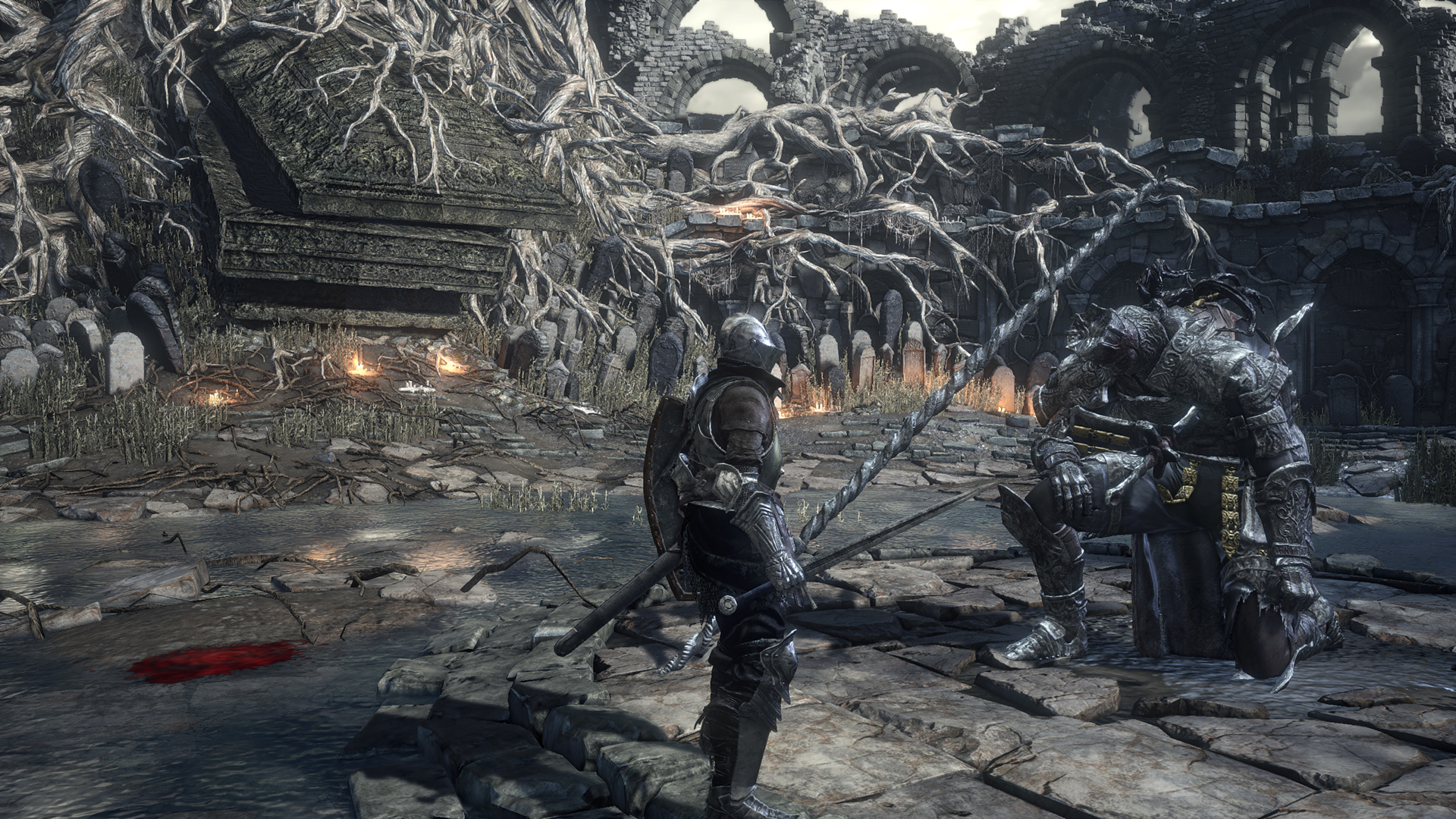
Due to all the fine detail on art assets that the series is known for, higher resolution, either in terms of downsampling or an actual higher resolution display, greatly improves the overall look of the game even beyond the standard advantages in terms of aliasing. This advantage comes at a significant cost however, with Dark Souls 3 being one of the games for which performance scales most directly with resolution that I have tested recently. What this means is that e.g. going from 1080p to 2560x1440 will incur an increase in performance requirements by more than 60%, and going all the way to 4k will induce a GPU load over 3 times higher than rendering at 1080p. Consequently, at 1440p, my overclocked GTX970 produces between 45 and 60 FPS in most areas.
Testing with other GPUs, both from AMD and Nvidia, confirms that they generally fall in place where you would expect them according to their relative performance across most games. Also, with the latest Nvidia driver, SLI scaling works well—provided of course that you are in fact GPU limited and not CPU limited, like in the area mentioned in the CPU performance section above. If you have a high-end multi-GPU system, you're more likely to be limited by your CPU than your graphics horsepower, unless you're rendering Dark Souls 3 at 4K or higher resolutions.
Graphics options
Beyond resolution, Dark Souls 3 offers a rather large range of graphics options, but most of them are not as wide-reaching in their effect. I’ll quickly go over each of them in turn, in the order they are presented in in-game. Note that some settings require a reload to take effect, while others perform immediate in-game changes.
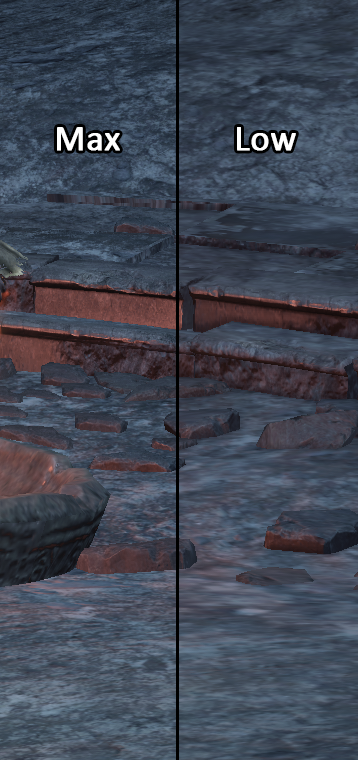
Texture quality seems to affect both texture resolution and texture filtering. At the maximum level, full anisotropic filtering is performed and the highest resolution textures available seem to be loaded for everything. At lower levels, both filtering and texture quality is reduced, as illustrated to the right. To me, the impact of the reduction in filtering quality is actually the more directly problematic part. As such, it might be interesting for gamers with GPUs on the lower end of the memory scale (less than 2GB) to lower this setting while forcing full AF in their graphics drivers.
The impact of this setting on GPU performance is low, at least as long as you have sufficient GPU memory available. I measured an impact between 2% and 8% depending on the situation going from “Low” all the way to “Max”.
The biggest gaming news, reviews and hardware deals
Keep up to date with the most important stories and the best deals, as picked by the PC Gamer team.
The second option offered is Antialiasing, a simple binary on/off choice. As you would expect in such a case, what is on offer is a simple post-processing solution, but at least it is a very competently implemented one, with little in the way of unintentional blur. With a tiny performance impact of less than 3% in all cases, I see no reason to ever disable this setting. Also, due to its good quality within the constraints of post-processing AA there is no need to inject an external replacement, unlike the previous games.
SSAO is one of the most meaningful graphical settings in the game. As always, the contact shadows it generates greatly increase the impression of depth in a rendered scene, and this is particularly true in a game with Dark Souls 3’s geometric complexity. There are three options available, “Off, “Low” and “High”. Interestingly, the latter two do not actually simply increase or decrease the intensity of the effect. “High” actually produces a more balanced ambient occlusion effect throughout the scene, and appears to take normal maps into account while “low” does not. While the “high” setting is not quite at the level of something like HBAO+ in terms of coverage, it is a very clean implementation which is thankfully free of all the unsightly issues and artifacts which plagued DS2’s default ambient occlusion.
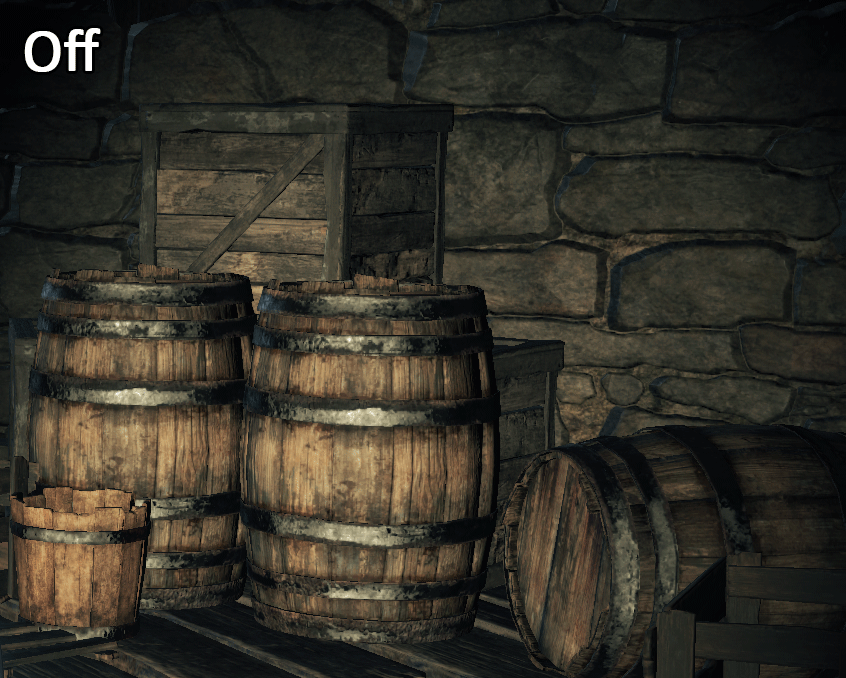
Click the image above for an animated comparison of the SSAO settings.
The animation above clearly illustrates the different settings. The “Low” setting adds depth to the scene, but comes with some outline artifacts and the common “drop shadow” issue of cheap AO solutions. “High” eliminates those artifacts, while also taking into account the wood grain and stone elevation normal maps, for a more balanced and pleasing overall AO result.
Performance-wise, “High” AO has an impact of 7-8% on my setup, and I really wouldn’t recommend anything other than “High” in most cases.
Depth of field and Motion blur settings both behave as you would expect. Progressively higher levels generate a progressively more accurate blur effect. Additionally, with motion blur, the lower settings only enable camera motion blur, while the higher options include per-object motion blur.
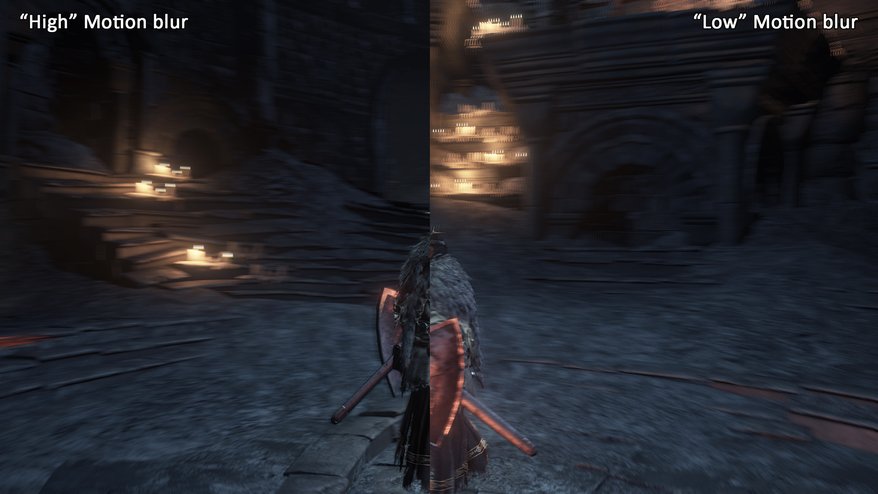
Each of these two settings has a non-negligible cost of 5-8%, and it is a performance penalty that remains regardless of whether any motion blur or out-of-focus objects are on screen. Therefore, I’d consider these two options prime candidates for lowering (or even turning off entirely) if you are missing that last bit of performance to reach 60 FPS.
Shadow quality is the final graphical setting which I would consider significant and immediately obvious. It’s also one of the few settings which actually has a (minor) impact on CPU performance, but only for the step from “Off” to any other option.
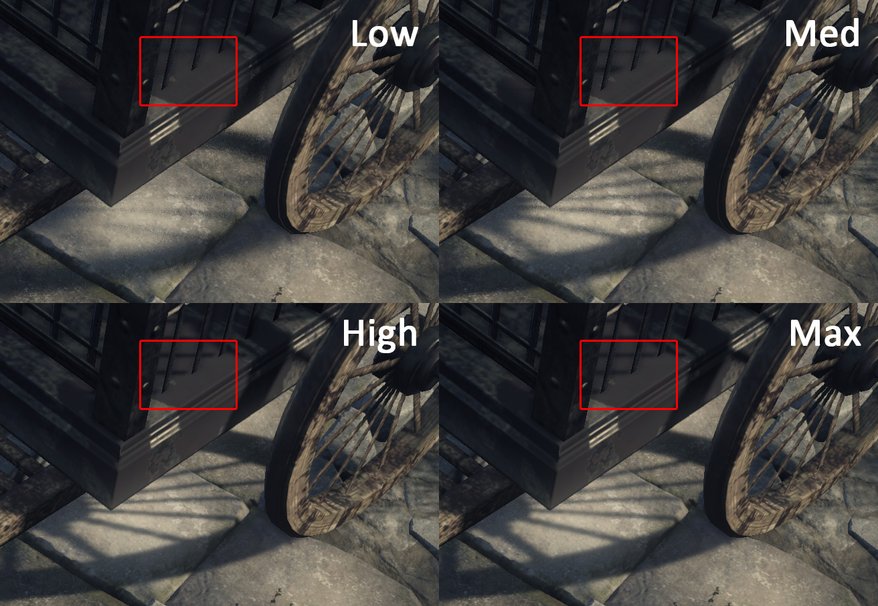
As the comparison shows, “Low” and “Medium” settings feature some dithering and noise which is not present in the “High” and “Max” rendering. This is actually more noticeable in motion in terms of image stability. One interesting difference between “High” and “Max” is that the latter seems to feature higher precision sampling and/or depth buffers, reducing the offset artifact in the area pointed out by the red outline.
In terms of GPU usage, the impact of shadows is rather moderate, but given the small visual difference between “High” and “Max” settings going down one step would not be a huge loss and one of the first things to try if you need slightly more performance.
All the remaining settings are rather minor both in their effect and their performance impact. Lighting quality enables a few more specular lights in very specific scenes. Effects Quality changes the fidelity of a few effects, e.g. adding a wobbly distortion on top of summoning signs. Reflection and Water surface quality both primarily affect water surfaces as you would expect, and finally Shader Quality is the one setting for which I couldn’t conclusively determine any particular effect.
Game stability and result reliability
Some of the initial reports about the PC version mentioned frequent crashes. In a bit over 15 hours so far, I haven’t experienced a single game crash, however I’ve had four driver crashes (and not the kind caused by overclocking, but rather the full-on BSOD kind). Such crashes generally cannot be caused by a bug in the game, but rather by a driver issue. Luckily, all of these occurred while I was trying out really high DSR resolutions in order to take screenshots—at playable settings both the game and the driver were stable on my system. Still, I hope this apparent driver issue is something which Nvidia addresses in the future, if only for the screenshots.
Talking about stability, I also want to mention something about the reliability and reproducibility of my measurements. As I said in the beginning, all of them were repeated multiple times in different situations, but I was not able to test everything throughout the entire game, and in particular wasn’t able to test multiplayer with a large number of participants. This means that there could well be particularly demanding situations which require a faster CPU and/or GPU than I identified above—this seems particularly likely as there are early reports of the console versions’ framerate turning into an “appalling slideshow” in some late-game areas.
Finally, there is a sporadic issue which can occur on monitors with a refresh rate greater than 60 Hz. When this happens, the game will seemingly use wrong timings for its frame limiter, resulting in a lowered framerate independent of actual performance. I wasn’t able to reliably reproduce this issue, so I don’t know exactly which conditions lead to it, but it should be possible to work around it by limiting your refresh rate to 60 Hz before launching Dark Souls 3.

Conclusion
Dark Souls 3’s day-and-date PC release is a very competent version of the game. It loads lightning fast, allows for arbitrary resolutions and runs at variable framerates up to 60 FPS, without any framerate-dependent gameplay effects I could identify. While it demands more in terms of CPU and GPU than its predecessor, this increase in requirements is commensurate with the increase in overall graphical fidelity—in most areas of the game at least, a few clearly suffer from performance issues. Generally, asset quality and detail is significantly improved, and the in-game AA and SSAO are of a quality which obviates the need for external injection.
The Dark Souls franchise has certainly come a long way on PC. It all started with a late port of the original which barely covered the essentials and only happened as the result of a petition, and yet attained unexpected popularity. And while the second game was far more competently ported, it was still late to release, somewhat overshadowed by a downgrade controversy, and not entirely ready to run at variable framerates.
With Dark Souls 3, of all these past issues, only embers remain. But as ash eternally seeketh embers, I still beseech From Software to try and support truly arbitrary framerates for their next masterpiece, and maybe not to include a low-performance area—even though it almost seems like a series tradition at this point.

